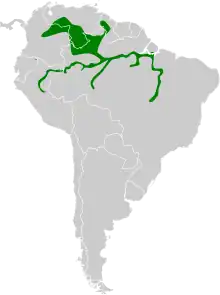Amazonian black tyrant
The Amazonian black tyrant (Knipolegus poecilocercus) is a species of bird of flycatcher known for its dominance in the Amazon wetlands. This medium-sized bird is characterized by distinctive features and a habitat preference that sets it apart from its environment.
| Amazonian black tyrant | |
|---|---|
%252C_Anavilhanas_islands%252C_%252C_Novo_Air%C3%A3o%252C_Amazonas%252C_Brazil.jpg.webp) | |
| A female amazonian black tyrant at Anavilhanas National Park, Novo Airão, Amazonas, Brazil | |
| Scientific classification | |
| Domain: | Eukaryota |
| Kingdom: | Animalia |
| Phylum: | Chordata |
| Clade: | Dinosauria |
| Class: | Aves |
| Order: | Passeriformes |
| Family: | Tyrannidae |
| Genus: | Knipolegus |
| Species: | K. poecilocercus |
| Binomial name | |
| Knipolegus poecilocercus (Pelzeln, 1868) | |
 | |
Here, the following is an overview for this fascinating bird species:
Description
The Amazon Black-Tyrant’s physical characteristics can be described as a rarely-encountered, medium-sized, dark flycatcher.It is often located in flooded forests along rivers (EBird). This bird encounters sexual dimorphism; males and females exhibit distinct characteristics. Males are shiny black, smaller, and glossier compared to make Riverside Tyrants. Females are warm brown with streaked underparts, and have a notably warmer coloration than female Riverside Tyrants (EBird).Notably, this species is known for its quiet nature among flycatchers(EBird). The Riverside Tyrant and Amazonian Black Tyrant look similar, however, the Riverside Tyrant is more prominent and frequently more noticeable in open riverine settings.
Taxonomy, Systemics and Characteristics
The universal name for the Amazon Black-Tyrant is Knipolegus Poecilocercus.First introduced to science by August von Pelzeln in 1868 in “Zur Ornithologie Brasiliens: Resultate von Johann Natterer Reisen in den Jahren 1817 bis 1835.” The Amazonian Black Tyrant is a part of the Monotypic Bird family: this bird species is the sole representative of its bird family, making it a unique and distinct taxonomic entirety. This bird can also be referenced to as Viudita amazonica, and in Brazilian Portuguese, pretinho-do-igapó
Habitat, Behavior and Ecology
These birds are typically found in low-flooded woodlands in their general vicinity, typically looking for insects that would be found near the ground or water. (IUC). The river corridors where you could find these birds would be along the Amazon and Oriconno(EBird). Since they are adept at foraging for insects near the ground or water, their ecological role is contributing to the ecological balance of their habitat. These bird’s geographical ranges are commonly found in river corridors along the amazon and oriconno rivers, thriving in an open riverine settings.
These birds are found in diverse habitats, influencing forests, shrublands, and wetlands, which are primarily inland areas. Their system are terrestrial and favor freshwater (inland) environments. Amazonian Black-Trants are not migratory birds, exhibiting sedentary behavior within their preferred habitats, they have limited movement patterns.
Conservation Status
Global Threat Status; despite a decreasing population trend, the Amazonian Black Tyrant is currently classified as “Least Concern” on the Red List of threatened species. This status is attributed to several factors. These species boast an extensive range, which does not meet the criteria for being classified as “vulnerable” under various criteria, including range size, population trend, and population size, which makes it fall under least vulnerable for the Red List Category. The precise population size remains unknown, but it is not believed to meet the “vulnerable” criteria under population size. This species’ breeding/resident range covers a vast area of 4,960,000 square kilometers. Amazonian Black Tyrants are not limited to a specific country, but distributed across multiple countries(datazone).
References
- BirdLife International (2016). "Knipolegus poecilocercus". IUCN Red List of Threatened Species. 2016: e.T22700228A93764991. doi:10.2305/IUCN.UK.2016-3.RLTS.T22700228A93764991.en. Retrieved 11 November 2021.
